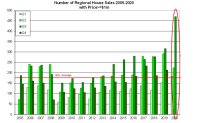
The housing market is hot right now in the Philadelphia region, and one of the surest signs yet that people are willing to pay for space in the suburbs is $1 million home sales.
Those spiked to record levels in the three months ending Sept. 30, according to a new report from Kevin Gillen, of Drexel University's Lindy Institute for Urban Studies.
Not only did $1 million home sales set a record, it smashed the previous record by 50%.
"Yep, this is real," Gillen bluntly put it, describing a chart showing $1 million home sales since 2005 and the newest quarter's total of 470 far beyond the previous quarterly record of 316 such sales.

He said another example of how hot the suburbs are amid the COVID-19 pandemic is the demand for amenities like pools and tennis courts. By extension, space for people who are now spending more time than ever at home.
"If you want to get a pool installed on the Main Line, there is an 18-month waitlist. That’s how much demand is there," Gillen said. "For many households, pools used to carry a discount instead of a premium in the home value. They take up a lot of space and if you have kids under a certain age, they are a potential danger. They now carry a huge premium."
Local
Breaking news and the stories that matter to your neighborhood.
Realtors like Kim Devereux of Keller Williams Brandywine Valley in West Chester said buyers are willing to pay a premium for houses in the suburbs right now because, in part, the interest rates for mortgages are so low.
She also noted that there is a definite influx of city dwellers "looking for more space."
"The buyers I’ve been working with are looking for more space and more open space. They're not looking to be on top of each other," Devereux said. "In addition to that, couples are now looking for homes with two offices because they're both working from home."
One of her friends recently moved back to the Philadelphia region after living in New York City for years, Devereux said.
"A dear friend that moved back from New York to the suburbs because of the dense population in the city," she said.
Gillen said New Yorkers appear to be contributing to the higher prices.
"A million dollars to someone coming from New York City doesn't sound like as much as it would to others," he said.
To see the full report published this week by Gillen as well as accompanying graphs showing historical trends, click here.



